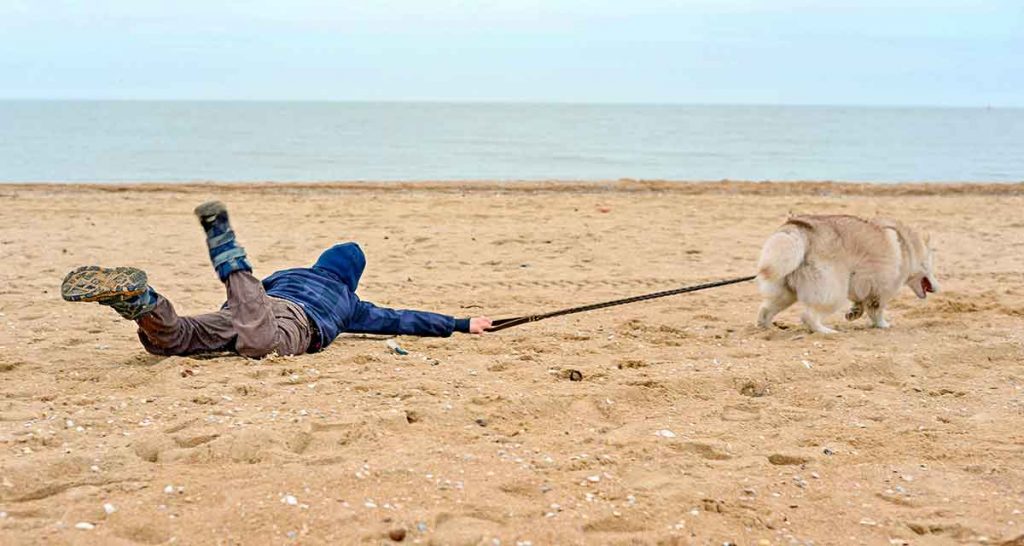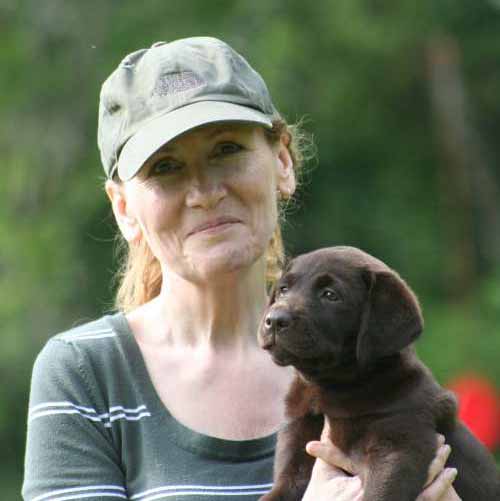
Pippa Mattinson, best-selling author and founder of the Dogsnet Training Program, brings us the latest information on the challenge of dogs with a deeply ingrained pulling habit.
I have written a number of articles about pulling on the leash and how to stop it. But it seems that there is always more to say!
Number one problem!
There’s always more to say because this is simply one of the biggest problems for owners of large strong dogs.
In fact, I’d go so far as to say that it’s the number one problem for large dog owners worldwide.
And it can make life with a dog really miserable. Not to mention hazardous.
Why do they do it?
Dogs pull on the leash because they think that pulling is what keeps them moving in the direction they want to go.
The reason that pulling on the leash is such a big problem is because most people inadvertently reward this behavior in their puppies, (when it doesn’t matter so much).
And then it becomes an ingrained habit.
How the habit takes hold
Many dogs continue to be rewarded for pulling throughout their lives.
The dog is rewarded either by being let off the leash after dragging their owner to the park, or by being repeatedly allowed to move in the direction that they are pulling towards.
If your dog drags you to the dog park each day, he is justified in believing that pulling is the only way to get to the dog park.
The cure?
I can’t rush in and tell you that there is a quick fix that will stop your dog from pulling on the leash, because there isn’t.
The effective, long term cure is to teach the dog that walking nicely at your side gets results, and that trying to charge off ahead of you gets them nowhere.
It goes without saying that this is not a goal you can achieve in an afternoon!
The bad news
So, the bad news is that curing leash pulling takes many weeks and much persistence. It could even take months if its a long standing problem.
Which is why it’s understandable that so many people give up before they are successful. But there is good news.
The good news
The good news, is that the cure works if you stick at it. Thousands of dogs with pulling habits have been cured, and your dog can be cured too.
In the meantime, there are management strategies that you can use to help prevent the problem getting worse, and to keep you and your dog safe.
Managing a puller
Managing a dog that pulls is a separate issue from training a dog not to pull.
And it’s an important issue because training takes time, and because pulling is a potentially dangerous behavior, especially in a large dog.
Harnesses and halters
Body harnesses with front attachments can help give dog owners some control over a hardened puller. As can head collars or halters.
And though the latter work because they are unpleasant for the dog, they are the lesser of several evils when it comes to providing a temporary control mechanism.
A control mechanism which is necessary in many cases, to keep the person holding on to the dog safe, and in some cases to keep others safe too.
Short term solutions
None of these management techniques is ideal, they all either interfere with the dog’s natural movement or behavior, or cause the dog some discomfort.
Pulling management techniques, should always be considered as a short term solution while the long term solution – training – is being put in place.
But my dog only pulls when….
Often people are looking for a very specific solution because their dog’s pulling behavior only occurs in specific situations.
Many dogs don’t pull on the leash all the time. They may pull
- As they leave the house, or go through doors & gateways
- When they see other dogs
- When they see other people
- When they see vehicles, toys or anything moving fast
The rest of the time these dogs may walk nicely on the leash, and their owner quite understandably assumes that the dog knows how to behave.
This can cause confusion.
Naughty dogs!
The natural conclusion if a dog knows how to behave, and fails to do so, is that the dog is choosing to disobey.
If a dog knows how to walk on a loose leash then surely when they do pull this is due to naughtiness or stubbornness.
Check out how to train a stubborn dog for some more insight into this problem!
A flawed assumption
For now though, I have to tell you that concluding your dog is stubborn or naughty is almost always a flawed assumption
And it is a flawed assumption that often leads dog owners to give up on training altogether, or resort to painful or abusive solutions such as electric shocks.
This assumption is flawed because it ignores the fact that all dogs learn based on the context in which that learning took place
Context based learning
The cause of a dogs inability to perform a known skill under distractions is due to a well documented canine attribute.
This is the poor ability of dogs to apply skills learnt in one situation, to a different one.
We usually refer to this as an inability to ‘generalize’ and it gets dogs into a whole heap of trouble. Happily, training can overcome this.
Training in different contexts
For all dogs, some contexts are more challenging than others. And every dog is different. Some dogs will struggle to walk nicely past a cat, for example, while another dog may struggle to walk past a child.
Well structured training enables dogs to learn at a simpler level before asking them to perform the same skills in more challenging situations.
The key is to repeat the same training in different contexts starting with the situation that your dog finds easier and working your way up to the most challenging distractions you are likely to meet.
Pulling versus walking to heel
Resolving the problem begins with switching your focus from what the dog is doing wrong (dragging you around on the end of his leash) to what we actually want the dog to do
Then teaching the dog to do that in achievable stages
And what you want the dog to do, is walk nicely alongside of you with their shoulder about level with your left leg. Otherwise known as walking to heel
Walking to heel
Heelwork is the polar opposite of pulling on the leash. The dog cannot pull if they are at heel.
In the heel position the dog is next to your leg and the leash will be loose.
Heelwork doesn’t have to be ‘competition’ level positioning, but you do need to decide what you expect and make sure that the dog meets those expectations.
How to teach heel
You will need to teach your dog to do this in a very quiet and confined area with no distractions. You won’t even need a leash to begin with.
Then one by one, as your dog succeeds you’ll introduce little distractions and temptations. Making sure all the time, that your dog can’t get at any rewards if he caves into the temptation to break from the heel position..
In other words, the only way he wins, is if he makes the right choice and stays at your side. You’ll find detailed instructions for teaching heel to your dog in our Core Skills training course. But here are some tips
Getting started
The first stage is to teach your dog that there is huge value in being next to your left leg.
You can do this by feeding your dog repeatedly in this position. In many different locations and contexts.
This isn’t about pushing or pulling your dog into position. Simply place treats on the floor, next to your left foot, many times a day. No force or coercion is needed.
Getting moving
Once the dog is seeking out the position next to your foot repeatedly, the second stage is about getting the dog moving forwards and backwards, over tiny distances.
You can do this next to a wall, fence or other barrier to help the dog keep a nice position facing forwards and next to you.
Including the leash
Teaching the dog to ignore a leash while working with them in the heel position is an important step as you progress.
Because you’ll need to be able to prevent the dog breaking position once you start to add distractions.
Proofing
Teaching a dog walk at your side is actually the easy part. But as we’ve seen, the dog needs to be taught to do this in different contexts.
This process of adding changes and distractions in incremental stages is what takes the time.
Trainers call this process ‘proofing’. And it’s what will enable you to walk your dog past other dogs, other people, etc, without being dragged off to greet them!
Proofing is a skill that you can learn and get better at with practice. And its a skill we teach throughout our training courses. Starting with Foundation Skills
Teaching a dog to walk to heel is hard
I’m not going to tell you that all this will be easy.
Some of the people who start, won’t succeed with teaching their dog to walk to heel. It’s hard and not everyone wants the cure badly enough to follow through.
Why some people fail
Some won’t use powerful enough rewards often enough and for long enough to get the new behavior established.
Some won’t set up the training scenarios required to practice in different contexts and to proof their heel work, so that the dog learns to walk at heel past increasingly tempting distractions.
Or they will skip stages in training so that the dog starts to fail increasingly often.
Your choice
Having a dog that walks politely next to you, no matter where you go, is a wonderful feeling.
The truth though, is that not everyone cares enough, or wants it enough, to invest the time required to succeed.
But the fact remains, that there is a cure, and that if you are doggedly persistent, you can fix this horrible pulling problem.
You can do this
Stopping your dog from pulling on the leash is within your grasp.
You can even teach your dog not to pull on the leash past kids and ball games, and when there are other dogs around.
You will need to invest some time – a few minutes – once or twice a day. And be prepared to stick at it, until the job is done.
Getting help
If you want the support of a structured training program, to do this, then you can enroll on one of our online training courses.
Core Skills is where we start to teach heel work, but the best place to begin the training program is with the Foundations Skills course. That course will give you the skills you need, to teach your dog the skills he needs.
You might also enjoy joining my Training Tips list, where I share free videos, tips and fun training guides on a range of different topics.
Just pop your name in the email box below to join the list.

Free Training Tips
Get Pippa's free dog training tips delivered to your inbox

 Exercising Your Dog In A Small Space
Exercising Your Dog In A Small Space
When we first took our puppy for training, the trainee taught us to ‘walk up the leash’ when we wanted to let our dogs to walk on a slack leash. First put knots in the leash. When the dog pulls on the leash while you go from up it knot by knot. You might have to adjust the knots.. The idea is to teach your dog that it does not need to pull. It worked for our pup.
What do we do for the dog’s exercise needs whilst we are teaching this?
I thought maybe take her to a park on a long lead and let her run around on it (I can’t take her off or she will run away) to give her exercise and just train to heel at home and in my street until she ‘gets it’?
Pippa has been extremely generous with training tips that work and I REALLY appreciate the e-mails!!
Wow! I’ve been consistently doing this with my lab and can I just say, it is the only Thing that has worked so far. Thank you for your knowledge!
give him or her little treats at heel and then as you go forward show the dog a treat and raise it to show that it will get it once you heal,hope this helps you
My dog will walk to heel but only while being treated, once this stops he moves forward. I call him to heel, he moves to position for a treat, then moves forward again.
How to retain the heel?
I have a 12 month beagle cross /foxhound, she wears a harness to try and control the pulling but it doesnt work shes only I interested in following scents she just doesnt listen to any commands ,as soon as we go outside she becomes a crazy hound hunting out scents ,shes not a large dog but very powerful and has pulled me off my feet several times when she has picked up a smell how do I stop this ,I have tried putting her on a short lead to keep her at my side or stopping and turning away from direction she is pulling in but that doesnt work ,any suggestions I have tried several harness and she still manages to drag me around the park
If a dog refuses to walk on a leash should I pull on the leash or how to get them to walk on the leash?
Start by reinforcing small efforts from your dog, like giving a small piece of a treat when they take just a few steps. Initially, this will encourage them to continue this behavior. Fade the use of those reinforces systematically over time and as the appropriate behavior increases. Hope this helps.
Hi, my dog only has selective hearing to come… what do I do??